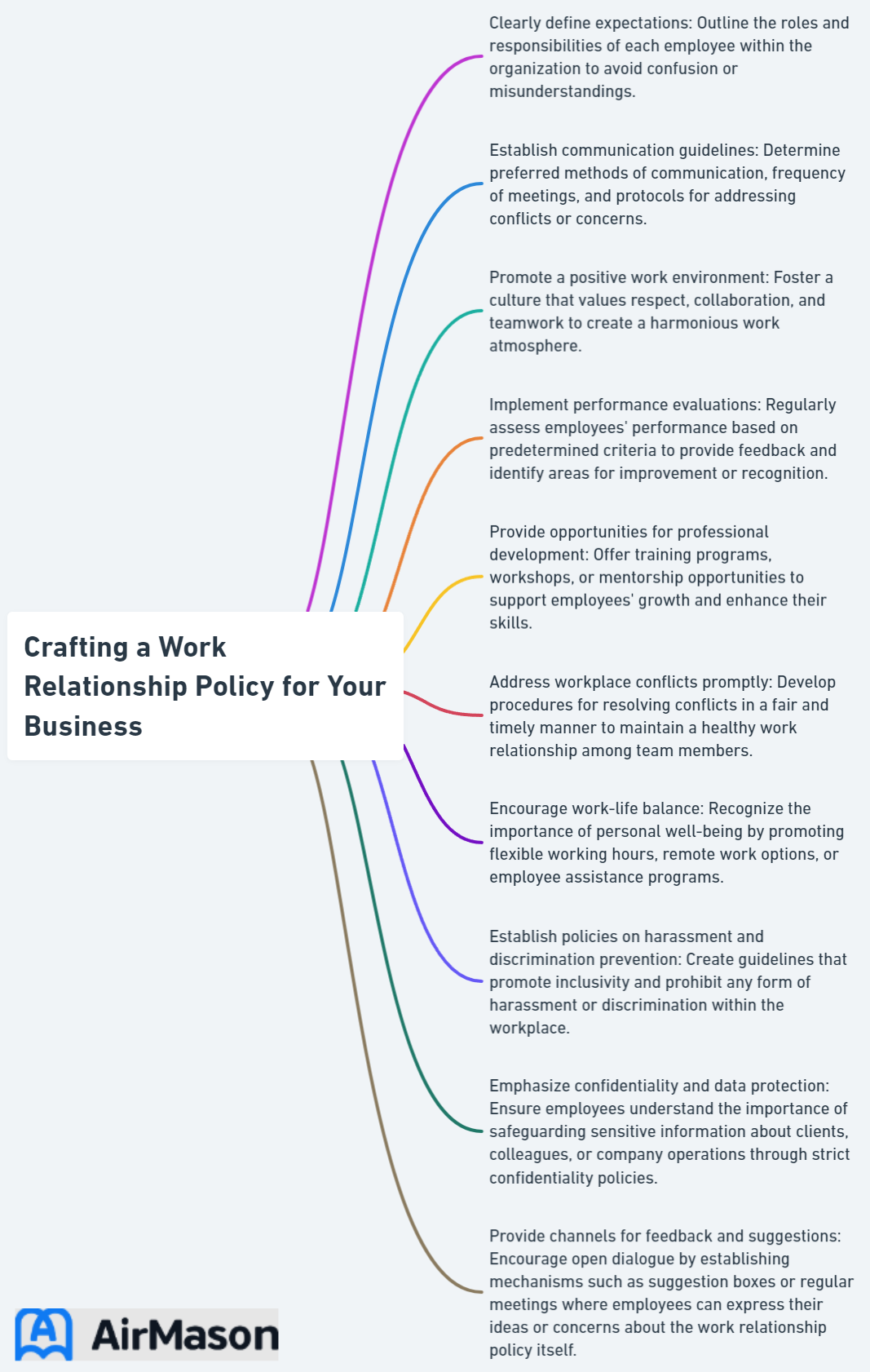
In today’s fast-paced and interconnected world, workplace relationships are becoming increasingly common and complex. Employers must navigate the delicate balance between respecting employees’ personal lives and ensuring professional responsibilities are met. Read on to discover how crafting a comprehensive work relationship policy can help manage potential risks, protect employees, and maintain a professional work environment.
Key Takeaways
- Work relationship policies are essential for creating a professional atmosphere and adhering to legal requirements.
- An effective policy should include scope, behavioral expectations, disclosure requirements and strategies to address power dynamics.
- Employers should communicate the policy effectively with training, disciplinary action & legal considerations while respecting employees’ personal lives.
Policy for Working Remotely
Our “Policy for Working Remotely” is designed to provide clear guidelines and expectations for employees engaging in remote work arrangements. As part of our commitment to fostering a flexible and productive work environment, this policy outlines the necessary protocols, communication channels, and security measures to ensure a seamless remote work experience. It emphasizes the importance of maintaining regular work hours, staying connected with team members, and adhering to company standards while working remotely. We believe that this policy not only supports our employees in achieving a healthy work-life balance but also contributes to the overall success of our organization by promoting efficiency and collaboration in a remote setting.
The Importance of a Work Relationship Policy
Workplace relationships, especially romantic ones, can pose potential risks if not managed properly. An employee dating policy, also known as a workplace romance policy, can help manage risks associated with workplace romances, such as the perception of retaliatory action (salary reductions, job transfers, or termination) if the relationship deteriorates. Given the more relaxed attitude of younger generations towards romantic relationships in the workplace, employers must communicate their workplace dating policy and behavioral expectations clearly. This helps prevent potential liabilities.
A well-crafted work relationship policy in the employee handbook can help maintain a harmonious work environment, preventing issues such as sexual harassment, power dynamics, and conflicts of interest. Companies need to establish clear guidelines and expectations for employees in romantic relationships to adhere to federal laws and maintain a professional atmosphere.

Key Components of an Effective Workplace Relationship Policy

An effective workplace relationship policy should encompass a clear scope, behavioral expectations, and disclosure requirements.
The forthcoming sections delve deeper into each of these components, highlighting their significance in upholding a professional workplace environment.
Scope
The scope of a workplace relationship policy should apply to all employees, regardless of gender or sexual orientation, and cover various types of relationships, from consensual romantic relationships to sexual relations. This ensures that the policy is inclusive and comprehensive, addressing all potential workplace dating scenarios.
Non-consensual relationships are explicitly forbidden by the policy, and employers should ensure that employees understand the consequences of engaging in such a relationship. A clear definition of what constitutes sexual harassment and how it is addressed in the policy aids in maintaining a safe and respectful work environment for all employees.
Behavioral Expectations
A workplace relationship policy should clearly delineate acceptable and unacceptable behaviors within the workplace, ensuring professionalism is maintained at all times. Employees should consider potential issues or conflicts of interest that may arise from workplace romances, such as:
- impacting work on significant projects
- creating a hostile work environment
- favoritism or perceived favoritism
- compromising confidentiality or privacy
Before initiating personal relationships with a colleague, employees should carefully consider these factors and be aware of the potential consequences.
For those employees who are married or in a domestic partnership, the policy needs to provide guidelines like preventing hiring managers from considering their spouse or partner for roles within their team or department. This helps to avoid potential conflicts of interest and ensures fairness in the workplace.
Disclosure Requirements
Disclosure requirements within the policy should clearly specify when and how employees should disclose their relationships to management or HR. While it has been found that disclosure requirements may not be particularly effective in deterring office romances or managing the repercussions of a relationship that has ended, they can still help employers stay informed and address potential issues before they escalate.
Employees need to comprehend the repercussions of not disclosing workplace relationships, which can include coercion, fear of repercussions, and potential harassment claims. Encouraging open communication and disclosure can help prevent misunderstandings and maintain a professional work environment, fostering healthy employee relationships.
Balancing Personal Lives and Professional Responsibilities

A well-crafted workplace relationship policies should strike a balance between respecting employees’ personal lives and ensuring professional responsibilities are met. Taking potential risks associated with workplace relationships, like sexual harassment and sexism, into account allows employers to create a policy that addresses these issues, while still permitting personal connections to form.
Some strategies that can be employed to achieve work-life balance include:
- Allocating blocks of time for different tasks
- Safeguarding personal space and establishing clear boundaries
- Providing flexible and remote working options
- Urging managers to prioritize work-life balance
- Facilitating employee well-being
By implementing these strategies, employers can create a workplace environment that respects personal lives and helps to maintain professionalism.
Flexible Working Policy
Our company understands the importance of adapting to the evolving needs of our workforce, and as such, we have implemented a robust Flexible Working Policy. This policy is designed to provide our employees with the flexibility they need to achieve a healthy work-life balance. Under our Flexible Working Policy, employees have the opportunity to explore alternative work arrangements, such as remote work or adjusted working hours, ensuring that they can meet both professional responsibilities and personal commitments. By embracing this Flexible Working Policy, we aim to foster a work environment that values individual needs, ultimately enhancing job satisfaction and productivity across our diverse tea
Addressing Power Dynamics and Potential Conflicts

Preventing favoritism, harassment, and other issues arising from workplace relationships necessitates addressing power dynamics and potential conflicts. Employers must be diligent in crafting policies that take into account the complexities of workplace power dynamics and the potential for conflicts of interest.
Some companies prefer that employees in romantic relationships not work in the same department or on the same team to avoid the potential for conflicts and maintain a professional atmosphere in the workplace. By being proactive in addressing power dynamics and potential conflicts, employers can create a work environment that is both supportive and professional, while minimizing the impact of office romance.
Implementing and Enforcing Your Work Relationship Policy

Implementing and enforcing a work relationship policy involves clear communication, training, and disciplinary action when necessary.
The subsequent sections provide a detailed discussion on each of these components, illuminating their contribution to the successful implementation of a workplace dating policy.
Communication Strategies
Employers should effectively communicate the work relationship policy to all employees and managers, ensuring everyone is aware of the expectations and consequences. Utilizing various communication channels, such as:
- Intranets
- Social media
- Chatbots
- Mobile apps
can help disseminate the policy and gather data on employee sentiment, behavior, and satisfaction.
Managers play a crucial role in communicating the work relationship policy. They should:
- Ensure that all employees are aware of the policy
- Help employees understand the policy’s expectations
- Foster open communication channels
- Address policy-related queries or concerns By doing so, managers can cultivate a supportive and professional workplace environment.
Training
Providing anti-harassment and relationship policy training can help employees understand the importance of maintaining a professional work environment. Training should cover key topics, such as:
- The definition and examples of harassment
- Types of harassment
- Consequences
- Reporting procedures
- Confidentiality
- Prevention strategies
- The role of managers and supervisors in addressing harassment
It is recommended that anti-harassment and relationship policy training be conducted in the workplace at least every two years. Regular training ensures that employees stay up to date on the latest best practices and reinforces the importance of maintaining professionalism in the workplace.
Disciplinary Action
Employers should have a clear process for handling policy violations, including potential consequences such as termination. A disciplinary action plan for violating a work relationship policy may include:
- Warnings
- Suspension
- Demotion
- Mandatory counseling or training
- Transfer to a different department
- Termination in cases of repeated or severe violations.
Implementing a progressive discipline policy, clearly communicating rules and expectations, applying disciplinary actions consistently, and maintaining thorough documentation are all recommended practices for establishing disciplinary actions in a work relationship policy. Consistent and fair enforcement of the policy enables employers to maintain a professional and supportive work environment.
Legal Considerations and Compliance
Crafting a work relationship policy that complies with relevant laws and regulations requires careful consideration of legal aspects and compliance. Consulting a legal expert when drafting an employee dating policy can help ensure adherence to local, state, and federal regulations.
Ensuring that a work relationship policy conforms to applicable laws and regulations is imperative to protect both the company and its employees. Keeping abreast of legal obligations and compliance allows employers to formulate a policy that promotes a respectful and professional work environment while minimizing potential liabilities.
Case Studies: Successful Work Relationship Policies in Practice

Case studies can provide valuable insights into successful work relationship policies and their implementation in various organizations. Examining the strategies and outcomes of different companies can help employers learn from real-world examples and adapt their policies accordingly.
Some successful work relationship policies have been characterized by:
- Clear boundaries
- Legal guidance
- Proactive communication
- Attention to power dynamics and potential conflicts
Employers can contribute to a harmonious and professional work environment by learning from these examples and implementing similar strategies in their work relationship policy, keeping their employees engaged.
Employee Health Policies
Our organization prioritizes employee well-being through comprehensive employee health policies. These guidelines are designed to foster a work environment that supports and promotes the physical and mental health of our workforce. We understand the importance of a healthy and happy team, and our employee health policies reflect our commitment to providing resources and initiatives that contribute to a thriving workplace. From wellness programs to preventive measures, we aim to create a culture where every team member feels supported in their journey towards a balanced and healthy lifestyle. These policies underscore our dedication to the overall well-being of our employees, fostering a workplace that values health as an integral part of professional success.
Summary
In conclusion, crafting a comprehensive work relationship policy is crucial for managing potential risks, protecting employees, and maintaining a professional work environment. By considering key components such as scope, behavioral expectations, and disclosure requirements, balancing personal lives and professional responsibilities, addressing power dynamics and potential conflicts, and ensuring legal compliance, employers can create a policy that fosters a supportive and productive workplace. As organizations continue to evolve and adapt to the changing landscape of workplace relationships, it is essential to stay informed and proactive, learning from successful examples and implementing best practices.
Frequently Asked Questions
What are the rules on relationships in the workplace?
Employers typically discourage romance between coworkers, as it can diminish productivity and lead to conflict or difficulties in the workplace. Policies on workplace relationships typically include mandatory disclosure to HR, a ban on superiors and subordinates being in a relationship, and signing of “love contract” agreements.
What is an example of a relationship policy in the workplace?
Employees in workplace relationships should disclose the relationship to the HR department, no superior-subordinate relationships are allowed, and both parties must acknowledge and sign a “love contract” agreement and anti-sexual harassment policies.
What constitutes an inappropriate work relationship?
Romantic or sexual relationships between employees where one individual has influence or control over the other’s conditions of employment constitute an inappropriate work relationship. These relationships, even if consensual, can result in conflict or difficulties in the workplace and are strongly discouraged.
How can employers strike a balance between respecting employees’ personal lives and ensuring professional responsibilities are met?
By allocating blocks of time for different tasks, safeguarding personal space, offering flexible and remote working options, and emphasizing work-life balance, employers can successfully strike a balance between respecting employees’ personal lives and ensuring professional responsibilities are met.
What are some effective communication strategies for disseminating a work relationship policy?
Utilize multiple channels to disseminate the policy, such as intranets, social media, chatbots, and mobile apps, while gathering data on employee sentiment, behavior, and satisfaction for optimal communication strategy.